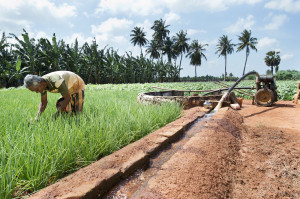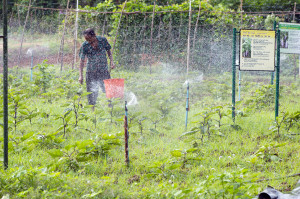Groundwater is the only reliable source of fresh water for most residents of the Jaffna Peninsula. Yet, as mentioned in a recent Lindha Langa article, this vital resource is currently undergoing rapid contamination from oil, sewage, and agrochemical dumping. Saltwater intrusion has also increased due to a higher rate of groundwater extraction as indicated by the International Water Management Institute’s (IWMI) 2013 aquifer characterization study in Jaffna. The resulting damage to the aquifer is very difficult to reverse, and any efforts to do so would take many years. Immediate action is necessary to ensure the sustainability of Jaffna’s groundwater resources for future generations.

Several strategies have been proposed to accomplish this goal. None can do the entire job alone, however. According to Herath Manthrithilake, Head, Sri Lanka Development Initiative, IWMI, a combination of approaches is needed to establish a more sustainable and equitable water management system in the Jaffna region. Five feasible strategies are outlined below; the first two are current government projects in development while the final three are potentially viable approaches based on IWMI analysis.
- The River for Jaffna Project. This proposed project aims to transform the three major lagoons within the Jaffna Peninsula from separate brackish water bodies into one, large freshwater lake. In order to do so, barrages (dam-like barriers) will be constructed to separate the three lagoons from the ocean, and a series of canals will connect them to form a single freshwater lagoon.While steps have been taken by the government to initiate this project over the last decade and even as far back as the 1950s, the project has frequently encountered roadblocks. Bunds and barrages have been constructed only to fall into disrepair; canal connectors have not been completed. Fishermen are concerned that the switchover from saline to freshwater will affect a shrimp species that is crucial for their livelihoods.
- The Jaffna Kilinochchi Water Supply and Sanitation Project (JKWSSP). The National Water Supply and Drainage Board (NWS&DB) plans to construct a pipeline that will transport water from the Iranamadu Tank in Kilinochchi to the Jaffna Peninsula and Kayts Island. Installment of a sewerage system in the Jaffna municipality is a major component of this project which aims to provide about 50,000 people with sanitation services and about 250,000 people with safe drinking water. This will reduce organic waste pollution as well as groundwater extraction in Jaffna. The Asian Development Bank (ADB) has provided funding, but some Kilinochchi farming communities in charge of the Iranamadu Tank have resisted the project due to concerns about over-extraction of water from the tank.
- Rainwater Harvesting (RWH). Along coastlines and densely populated areas, RWH can provide an alternative drinking water source to groundwater wells contaminated with excess saltwater and/or nitrates. This would also likely help to reduce the rate of groundwater extraction. Based on Jaffna’s average household population and rooftop size and even drought-like amounts of annual rainfall, RWH can provide a typical Jaffna household with its annual water requirements for cooking, drinking, and hand washing. In non-drought years, there would even be some water left over for other uses such as kitchen garden irrigation, bathing, or laundry. RWH systems can also be installed in schools to provide students with a daily litre of drinking water throughout the school year. The Lanka Rain Water Harvesting Forum is already implementing a RWH educational awareness campaign in Kilinochchi. Such awareness raising is crucial for successful RWH system adoption as indicated by IWMI (Aheeyar et al. 2014).
- Infiltration Pond Remediation. There are an estimated 1,000 small ponds within the Jaffna Peninsula with a retention capacity of millions of cubic meters of water. Historically, these ponds have been used for water retention during the rainy season, but many require repair after years of neglect. Local initiatives to clean-up these neighborhood water bodies for collective irrigation purposes could promote regionally driven water sustainability practices.

Man working in a farm irrigated by sprinklers in Jaffna (photo: Hamish John Appleby/IWMI). - Sprinkler Irrigation. Many farmers in the Jaffna region use hose-fed irrigation which requires more water than other types of irrigation. A switchover from hose-fed irrigation to less water-intensive sprinkler irrigation could drastically reduce groundwater extraction. A yet to be published IWMI research study outlines how a recent farmer-developed sprinkler irrigation initiative in the Kalpitiya region allowed farmers to increase cropping intensity and profits while also reducing irrigation requirements. These new irrigation systems use locally available materials, thus allowing for cheap and convenient repairs. “Encouraging farmers in Jaffna to incorporate similar innovations could not only reduce groundwater extraction but also enhance the farmers’ quality of life,” said Manthrithilake.
There is no single initiative that represents a catch-all solution. As such, local authorities must pursue several strategies together to ensure sustainable water resources in Jaffna for years to come. The time to act is now, to ensure these strategies remain viable.
Reference
Aheeyar, Mohamed M. M.; Ariyananda, T. 2014. Domestic rainwater harvesting interventions in Sri Lanka: some lessons learnt. In Lanka Rain Water Harvesting Forum. Proceedings of the 11th Symposium on Mainstreaming Rainwater Harvesting as a Water Supply Option, Colombo, Sri Lanka, 5 September 2014. Colombo, Sri Lanka: Lanka Rain Water Harvesting Forum.pp.64-70. Available at https://drive.google.com/file/d/0B8hkh22KemLuYXZDWExYbTBOSmc/view (last accessed on 15 May 2015).
By Paul Rink, Research Uptake Intern, IWMI

